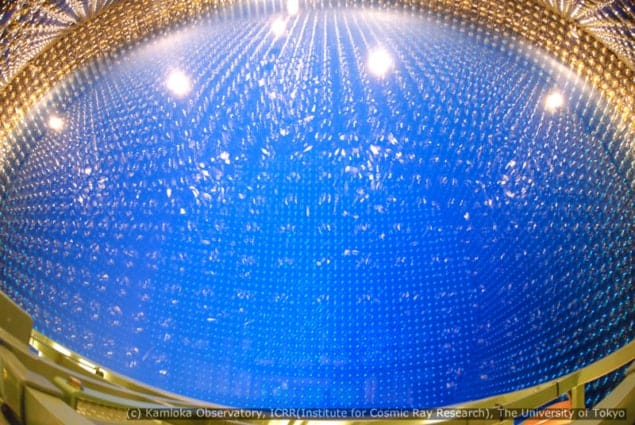
Physicists at the Tokai-to-Kamioka (T2K) experiment in Japan claim to have measured, for the first time, muon neutrinos changing into electron neutrinos. The effect could allow researchers to pinpoint the final undetermined neutrino “mixing angle” as well as provide a clue toward solving the mystery of why matter, rather than antimatter, dominates the universe.
Neutrinos exist in three “flavours” – muon, electron and tau – that change or “oscillate” from one to another as they travel in space and are very hard to detect because they interact weakly with matter. Researchers at T2K generate neutrinos at the $1.5bn Japan Proton Accelerator Research Complex (J-PARC) based in Tokai on the east coast of Japan. The facility accelerates protons to around 30 GeV and then fires them into a graphite target to produce pions, which then decay into muons – heavier cousins of the electron – and muon neutrinos.
After passing through a detector that determines how many muon neutrinos are in the beam, the particles are sent underground to the vast SuperKamiokande detector in Hida, some 300 km north-west of Tokai on Japan’s west coast. SuperKamiokande consists of 50,000 tonnes of water surrounded by 11,146 photomultiplier tubes, each 50 cm in diameter. The photomultiplier tubes pick up the radiation emitted when a neutrino interacts with a water molecule.
Changing flavours
The oscillation strength between different types of neutrino is characterized by three “mixing angles” – known as theta-12, theta-23 and theta-13. T2K’s predecessor, the KEK to Kamioka (K2K) experiment, as well as the KAMland experiment in Japan and the Sudbury Neutrino Observatory in Canada, have already measured theta-12 and theta-23. Theta-12 was estimated from the difference in the number of electron neutrinos ought to originate from the Sun and the smaller numbers actually detected, which were presumed to have oscillated into other flavours as they travel to Earth. Similarly, for theta-23, researchers looked at atmospheric neutrinos and observed a deficit in the expected number of muon neutrinos.
Now, researchers at J-PARC have made a step towards measuring the final mixing angle – theta-13 – by measuring muon neutrinos oscillating into electron neutrinos. From January 2010 until March this year, the SuperKamiokande detector observed 121 neutrinos that clearly originated from the J-PARC neutrino beam. The background signal, which could mimic a signal from electron neutrinos that are present anyway, was estimated to be around 1.5 events. However, over 13 months, researchers at T2K, which has more than 500 researchers from 12 countries, spotted six events arising from muon neutrinos turning into electron neutrinos. The probability of observing, by chance, six events when only 1.5 are expected is 0.7%, or a little less than 1 in 100.
“The result is not enough to claim a discovery, but it is important for not only T2K but also high-energy physics in general,” says Koichiro Nishikawa, former spokesperson for the T2K experiment and based at the KEK particle physics lab in Tsukuba. “This result is also, except for one ‘tau event’ in the OPERA experiment at Gran Sasso in Italy, the first time that anyone has shown that neutrino oscillations occur as a change of flavour.”
Data collecting at Kamioka, however, was cut short due to the Tohoku earthquake that struck north-east Japan on 11 March and which badly hit the J-PARC facility, affecting roads and buildings. J-PARC will remain closed until later this year when lab officials hope to start powering up the accelerators again. “It is very unfortunate that we lost most of this year’s running, as otherwise (assuming we aren’t the victim of a statistical fluke) we would have something pretty convincing by now,” says Dave Wark of Imperial College London and former international co-spokesperson for T2K.
When J-PARC restarts, Nishikawa adds that physicists on T2K should be able to get a good estimate for theta-13 by “summer 2013”. After a few years, researchers will also switch to generating anti-muon neutrinos that could oscillate into anti-electron neutrinos. As the initial and final states can be measured this could give a clear indication if there is any difference between the behaviour of matter and antimatter particles. The experiment will then also search for “charge-parity” violation in different kinds of leptons, which could help us better understand why there is much more matter than antimatter in the universe.
The work has been submitted to Physical Review Letters.



